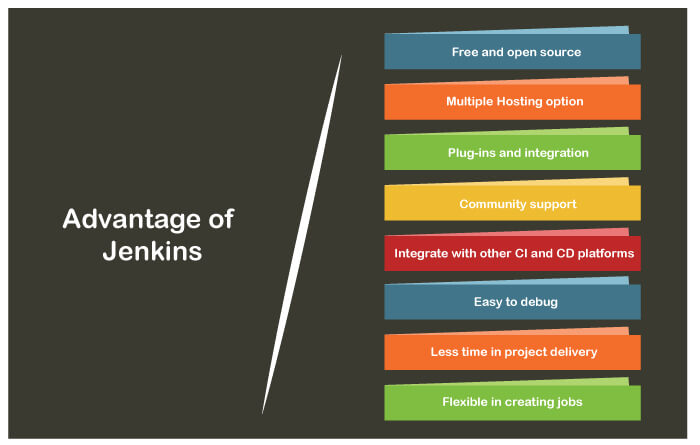Advantages and Disadvantages of Jenkins
Advantages of Jenkins
Jenkins is not the only option for continuous integration in the market; however, there are some other tools also available to do the same. But the Jenkins is more important and most widely used because of its use and amazing features. It would help if you spend some time studying Jenkins, and definitely, it will give you a lot of amazing features beyond your imagination. It is also known as the Heart of the DevOps pipeline. There are a lot of benefits of using the Jenkins pipeline; a few of them are given below:

- Open Source and Free: Developers don’t need to take tension about the money; it is free of cost. It is platform-independent.
- Plug-ins and Integration: It is one of the most important features that make it most widely used. It has its type of plug-in, which helps the developer a lot in executing the jobs. Jenkins plug-ins can be developed by anyone and for anyone. Dashboard view plug-in, test analysis plug-in, build pipeline plug-in, and many more like this makes the developer familiar with the Jenkins tool.
- Hosting Option: It is yet another important feature of the Jenkins, which can be installed on any operating system like Windows, MacOS, Linux, etc. You can also run Jenkins on the cloud by downloading and deploying it on a VM. You can also use a Docker container in it.
- Community Support: Jenkins has great support from the developer community. You can assume its popularity and community support that it has more than 1000000 users all over the world, while it was officially published in 2011.
- Integration with other CI/CD platforms: Jenkins supports many CI/CD platforms, not only the pipeline. It can make interaction with other tools also. Several plug-ins are available in it, which allows users to make connections with other CI/CD platforms.
- Keep your team in sync: Jenkins focuses on a centralized way of working. All the members of the team move in sync.
- Easy to debug: It is very easy to find out the errors in the Jenkins. The developer can easily check the bug and resolve it.
- Less time to deliver the project: It happens because of its continuous integration feature.
- Flexible in creating the jobs: It is very flexible in creating the jobs. It can create jobs both in freestyle and in the pipeline process very easily.
- Source Code Management (SCM): Jenkins supports different types of source code repositories like SVN, Git, etc. The developer can set different trigger after making changes in the codes. He can do it every time.
- It makes the process of converting in GUI from CLI very easy.
- It provides accurate data support to project management.
- It supports many languages, like Java, Python, etc.
Disadvantages of Jenkins:
Following are some cons of the Jenkins tool:
- All plug-ins are not compatible with the declarative pipeline syntax.
- Jenkins has many plug-ins in its library, but it seems like they are not maintained by the developer team from time to time. This is when it becomes very important that whatever plug-ins you are going to use; are getting a regular update or not.
- Lots of plug-ins have a problem with the updating process.
- It is dependent on plug-ins; sometimes, you can't find even basic things without plug-ins.
- Jenkins UI is not user friendly in comparison to current UI Technologies. It cannot be very clear for the first-time user.
- Managing of Jenkins dashboard is hard when we have too many jobs to be executed.
- Changes made by a developer will not be visible to another developer of the team; only the manager can have its access. It makes tracking difficult in large projects.
- Although many plug-ins are available, it does not provide the analytical support in the end to finish the deployment cycle. It leads to the creation of difficulties in the tracking of the project deployment.
- The error message is not clear sometimes. It becomes hard to find out what went wrong.
- You have to maintain your infrastructure by yourself.
- It is not easy to install and configuration the Jenkins tool.